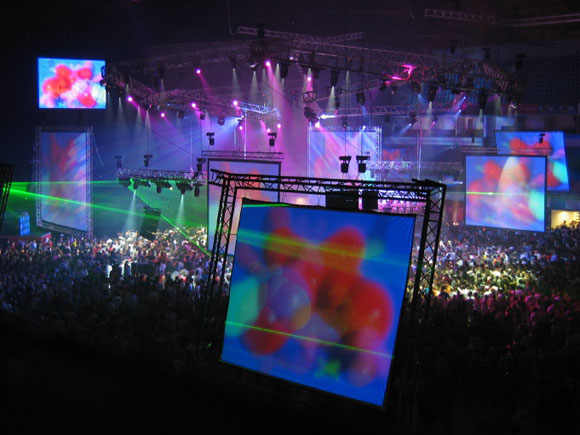
In celebration of tonight’s monthly Eyewash party here in NYC, CDM brings you a day of VJ coverage. And yes, I’ll be on tonight, so New Yawkas, stop by and say hi. To get things rolling, we’ve got a letter (cue the Official Mailbag Theme Song). Wally writes:
I saw that you are going to be VJing soon, and I wanted to ask what tools you use to VJ, and also, what is your approach? I’ve been asked by some friends of mine to VJ a gig of theirs on July 9th, and while I’ve played around with a couple tools here and there (Union, Resolume, Grid) I’m a little intimidated by the project.
At any rate, a friend of mine loaned me a Panasonic video mixer, so I’m planning on running Resolume on the PC, and either Grid or Union on my Powerbook — can’t decide which. My goal is to have tightly integrated video with the audio, but it seems like that’s more difficult with VJ apps for some reason. I realize that one has to have an exact number of frames to get video to loop in sync with audio at certain BPMs, but very few VJ apps seem to have clip playback control that starts and stops with MIDI clock.
(Read more for the answer)
VJ software is right now deluged with similar tools. First off, you’ve done absolutely the right thing with a hardware VJ mixer — definitely a must if you can get your hands on one. You can add hardware effects on the mixer to save your CPU, and of course cross-fade between cued stuff on each machine, especially in the event of the crash.
For software: Resolume looks very cool, and tops my list of tools to check out on Windows, thanks to full video scratching, MIDI controllers, Flash and support for the open FreeFrame plugin format. (Mac users, Resolume is PC-only.)
Union has a similar feature set on Mac. I’ve seen a fair number of people using Union, and it seems to work well. All of these apps are fairly feature-driven. (Windows is promised, but I haven’t seen it yet.) GRID2, in contrast, is really bare-bones: it stores a bunch of clips in a grid, and can play them back, scratch them, quantize them to a beat . . . and that’s it. But that may be exactly what you want.
KISS: In fact, that’s the question I’d ask myself: how much do you want to do in your first set? If you’re nervous or intimidated, go simple. In fact, a lot of VJs I’ve seen pull too many stops as far as video effects and wind up destroying some of the beauty of their footage. It’s too bad GRID Pro isn’t out yet; it should take the simplicity of GRID but add some extra bells and whistlles, which could make it the killer app. (I’ve been very impressed with Vidvox’s software.)
The Free One: While you mull this over, let me throw one last recommendation into the ring: if you’re having trouble deciding, why not give the free Neuromixer software a try. These free apps were all built in Max/MSP Jitter, they’re cross-platform, and they work really well. (Like a lot of Jitter patches, you probably will want to ramp down your video size to 320×240, though, so it’s best for pixel-aesthetic.) And here’s my confession: I’ll probably be using AVMixer Pro tonight on my PC, hooked up to a control surface for scratching. (More on that soon. Then again, I may switch to GRID2 at the last minute.) I’m trying some of the other tools, as well, but while I work on my own custom patches for Jitter and Quartz Composer, Neuromixer fits the bill for the time being! It’s super-simple, but with more than enough features, it’s great for beginners, and you can use it after a few drinks. Or, uh, so I’ve heard.
What about going modular? While I wouldn’t necessarily suggest it by July 9, Max/MSP Jitter is a flexible environment for creating your own custom patches — and Neuromixer should give you some inspiration. Or for a system built for modular patching a la Jitter but more optimized for VJ and live video work, check out Vidvox’s excellent VDMX. Much as I love Jitter for general-purpose work, VDMX is really geared for video.
Beat sync: As for beat sync, a number of apps can slave to MIDI clock . . . but that kills the fun. I think it’s better to do this live. Make sure you’ve got a tap tempo (so far, I’m fairly certain all the apps we’ve mentioned so far do) and set tempo manually. This gives you lots more flexibility to determine what the tempo is, break with it, go loose.
Anyway, that’s my initial take. Other ideas? I would love to do an all-app VJ roundup in July; as you can tell, you’ve got my wheels turning on this one!